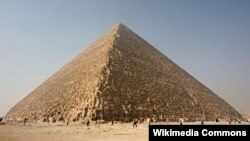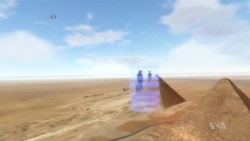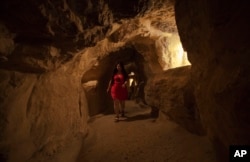A team of scientists who last week announced the discovery of a large void inside the Great Pyramid of Giza have created a virtual reality tour that allows users to "teleport" themselves inside the structure and explore its architecture.
Using 3-D technology, the Scan Pyramids Project allows visitors wearing headsets to take a guided tour inside the Grand Gallery, the Queen's Chamber and other ancient rooms not normally accessible to the public, without leaving Paris.
"Thanks to this technique, we make it possible to teleport ourselves to Egypt, inside the pyramid, as a group and with a guide," said Mehdi Tayoubi, co-director of Scan Pyramids, which on November 2 announced the discovery of a mysterious space inside the depths of the Pyramid.
WATCH: Explore the Great Pyramid of Giza
The void itself is visible on the tour, appearing like a dotted cloud.
"What is new in the world of virtual reality is that from now on, you are not isolated," Tayoubi said. "You're in a group — you can take a tour with your family. And you can access places which you usually can't in the real pyramid."
While partly designed as a fun experience, the "collaborative immersion" project allows researchers to improve the technologies they used to detect the pyramid void and think about what purpose it may have served.
Ancient wonder
The pyramid, built around 2,500 B.C. and one of the seven wonders of the ancient world, was a monumental tomb soaring to a height of 479 feet (146 meters). Until the Eiffel Tower was built in 1889, the Great Pyramid stood as the tallest man-made structure for more than 4,000 years.
While there are passageways into it and chambers in various parts, much of the internal structure had remained a mystery until a team from France's HIP Institute used an imaging method based on cosmic rays to gain a view inside.
So-called muon particles, which originate from interactions with rays from space and atoms in Earth's upper atmosphere, are able to penetrate hundreds of meters through stone before being absorbed. That allows for mapping inside stone structures.
"Muon tomography has really improved a lot due to its use on the pyramid, and we think that muography will have other applications in other fields," said Tayoubi. "But we also wanted to innovate and imagine devices to allow the wider public to understand what this pyramid is, understand it from within."
When looking through their 3-D goggles, visitors can see the enormous stones of the pyramid as if they were real, and walk virtually along its corridors, chambers and hidden spaces.
As they approach the pyramid from the outside, the tour even includes audio of Cairo's deafening and ever-present traffic.









